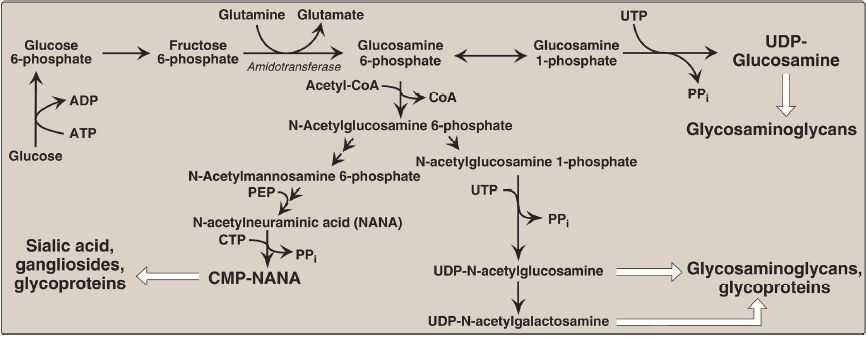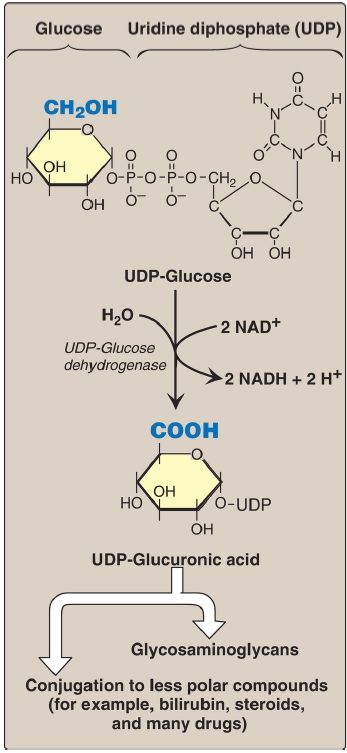


 النبات
النبات
 الحيوان
الحيوان
 الأحياء المجهرية
الأحياء المجهرية
 علم الأمراض
علم الأمراض
 التقانة الإحيائية
التقانة الإحيائية
 التقنية الحيوية المكروبية
التقنية الحيوية المكروبية
 التقنية الحياتية النانوية
التقنية الحياتية النانوية
 علم الأجنة
علم الأجنة
 الأحياء الجزيئي
الأحياء الجزيئي
 علم وظائف الأعضاء
علم وظائف الأعضاء
 الغدد
الغدد
 المضادات الحيوية
المضادات الحيوية|
Read More
Date: 7-9-2021
Date: 26-12-2021
Date: 1-11-2021
|
Synthesis of Glycosaminoglycan
The heteropolysaccharide chains are elongated by the sequential addition of alternating acidic and amino sugars donated primarily by their uridine diphosphate (UDP) derivatives. The reactions are catalyzed by a family of specific glycosyltransferases. Because GAG are produced for export from the cell, their synthesis occurs primarily in the Golgi and not in the cytosol.
A. Amino sugar synthesis
Amino sugars are essential components of glycoconjugates such as proteoglycans, glycoproteins, and glycolipids. The synthetic pathway of amino sugars (hexosamines) is very active in connective tissues, where as much as 20% of glucose flows through this pathway.
1. N-Acetylglucosamine and N-acetylgalactosamine: The monosaccharide fructose 6-phosphate is the precursor of N-acetylglucosamine (GlcNAc) and N-acetylgalactosamine (GalNAc). A hydroxyl group on the fructose is replaced by the amide nitrogen of a glutamine, and the glucosamine 6-phosphate product gets acetylated, isomerized, and activated, producing the nucleotide sugar UDP-GlcNAc (Fig. 1). UDP-GalNAc is generated by the epimerization of UDP-GlcNAc. It is these nucleotide sugar forms of the amino sugars that are used to elongate the carbohydrate chains.
 Figure 1: Synthesis of the amino sugars. ADP = adenosine diphosphate; UTP and UDP = uridine tri- and diphosphates; CoA = coenzyme A; PEP = phosphoenolpyruvate; CTP and CMP = cytidine tri- and monophosphates; PPi = pyrophosphate.
Figure 1: Synthesis of the amino sugars. ADP = adenosine diphosphate; UTP and UDP = uridine tri- and diphosphates; CoA = coenzyme A; PEP = phosphoenolpyruvate; CTP and CMP = cytidine tri- and monophosphates; PPi = pyrophosphate.
2. N-Acetylneuraminic acid: NANA, a nine-carbon, acidic monosaccharide , is a member of the family of sialic acids, each of which is acylated at a different site. These compounds are usually found as terminal carbohydrate residues of oligosaccharide side chains of glycoproteins, of glycolipids, or, less frequently, of GAG. NAcetylmannosamine 6-phosphate (derived from fructose 6-phosphate) and phosphoenolpyruvate (an intermediate in glycolysis) are the immediate sources of the carbons and nitrogens for NANA synthesis (see Fig. 1). Before NANA can be added to a growing oligosaccharide, it must be activated to cytidine monophosphate (CMP)-NANA by reacting with cytidine triphosphate (CTP). CMP-NANA synthetase catalyzes the reaction. [Note: CMP-NANA is the only nucleotide sugar in human metabolism in which the carrier nucleotide is a monophosphate rather than a diphosphate.]
B. Acidic sugar synthesis
D-Glucuronic acid, whose structure is that of glucose with an oxidized carbon 6 (−CH2OH → −COOH), and its C-5 epimer, L-iduronic acid, are essential components of GAG. Glucuronic acid is also required for the detoxification of lipophilic compounds, such as bilirubin , steroids , and many drugs, including the statins , because conjugation with glucuronate (glucuronidation) increases water solubility. In plants and mammals (other than guinea pigs and primates, including humans), glucuronic acid is a precursor of ascorbic acid (vitamin C) as shown in Figure 2. This uronic acid pathway also provides a mechanism by which dietary D-xylulose can enter the central metabolic pathways.
 Figure 2: Metabolism of glucuronic acid. NADPH = reduced nicotinamide adenine dinucleotide phosphate; CO2 = carbon dioxide.
Figure 2: Metabolism of glucuronic acid. NADPH = reduced nicotinamide adenine dinucleotide phosphate; CO2 = carbon dioxide.
1. Glucuronic acid: Glucuronic acid can be obtained in small amounts from the diet and from the lysosomal degradation of GAG. It also can be synthesized by the uronic acid pathway, in which glucose 1-phosphate reacts with uridine triphosphate (UTP) and is converted to UDP-glucose.
Oxidation of UDP-glucose produces UDP-glucuronic acid, the form that supplies glucuronic acid for GAG synthesis and glucuronidation (Fig.3). The end product of glucuronic acid metabolism in humans is Dxylulose 5-phosphate, which can enter the pentose phosphate pathway and produce the glycolytic intermediates glyceraldehyde 3-phosphate and fructose 6-phosphate (see Fig. 2).

Figure 3: Oxidation of UDP-glucose to UDP-glucuronic acid. NAD(H) = nicotinamide adenine dinucleotide.
2. l-Iduronic acid: Synthesis of L-iduronic acid occurs after D-glucuronic acid has been incorporated into the carbohydrate chain. Uronosyl 5- epimerase causes epimerization of the D- to the L-sugar.
C. Core protein synthesis
The core protein is made by ribosomes on the rough endoplasmic reticulum (RER), enters the RER lumen, and then moves to the Golgi, where it is glycosylated by membrane-bound glycosyltransferases.
D. Carbohydrate chain synthesis
Carbohydrate chain formation is initiated by synthesis of a short linker on the core protein on which carbohydrate chain synthesis will occur. The most common linker is a trihexoside formed by the transfer of a xylose from UDP-xylose to the hydroxyl group of a serine (or threonine) catalyzed by xylosyltransferase. Two galactose molecules are then added, completing the trihexoside. This is followed by sequential addition of alternating acidic and amino sugars (Fig. 4) and epimerization of some D-glucuronyl to Liduronyl residues.

Figure 4: Synthesis of chondroitin sulfate. PAP- = 3´-phosphoadenosyl-5´-phosphosulfate; Ser = serine.
E. Sulfate group addition
Sulfation of a GAG occurs after the monosaccharide to be sulfated has been incorporated into the growing carbohydrate chain. The source of the sulfate is 3´-phosphoadenosyl-5´-phosphosulfate ([PAPS] a molecule of adenosine monophosphate with a sulfate group attached to the 5´-phosphate). The sulfation reaction is catalyzed by sulfotransferases. Synthesis of the sulfated GAG chondroitin sulfate is shown in Figure 4.[Note: PAPS is also the sulfur donor in glycosphingolipid synthesis .]
A defect in the sulfation of the growing GAG chains results in one of several autosomal-recessive disorders, the chondrodystrophies, which affect the proper development and maintenance of the skeletal system.



|
|
|
|
لصحة القلب والأمعاء.. 8 أطعمة لا غنى عنها
|
|
|
|
|
|
|
حل سحري لخلايا البيروفسكايت الشمسية.. يرفع كفاءتها إلى 26%
|
|
|
|
|
|
|
جامعة الكفيل تحتفي بذكرى ولادة الإمام محمد الجواد (عليه السلام)
|
|
|